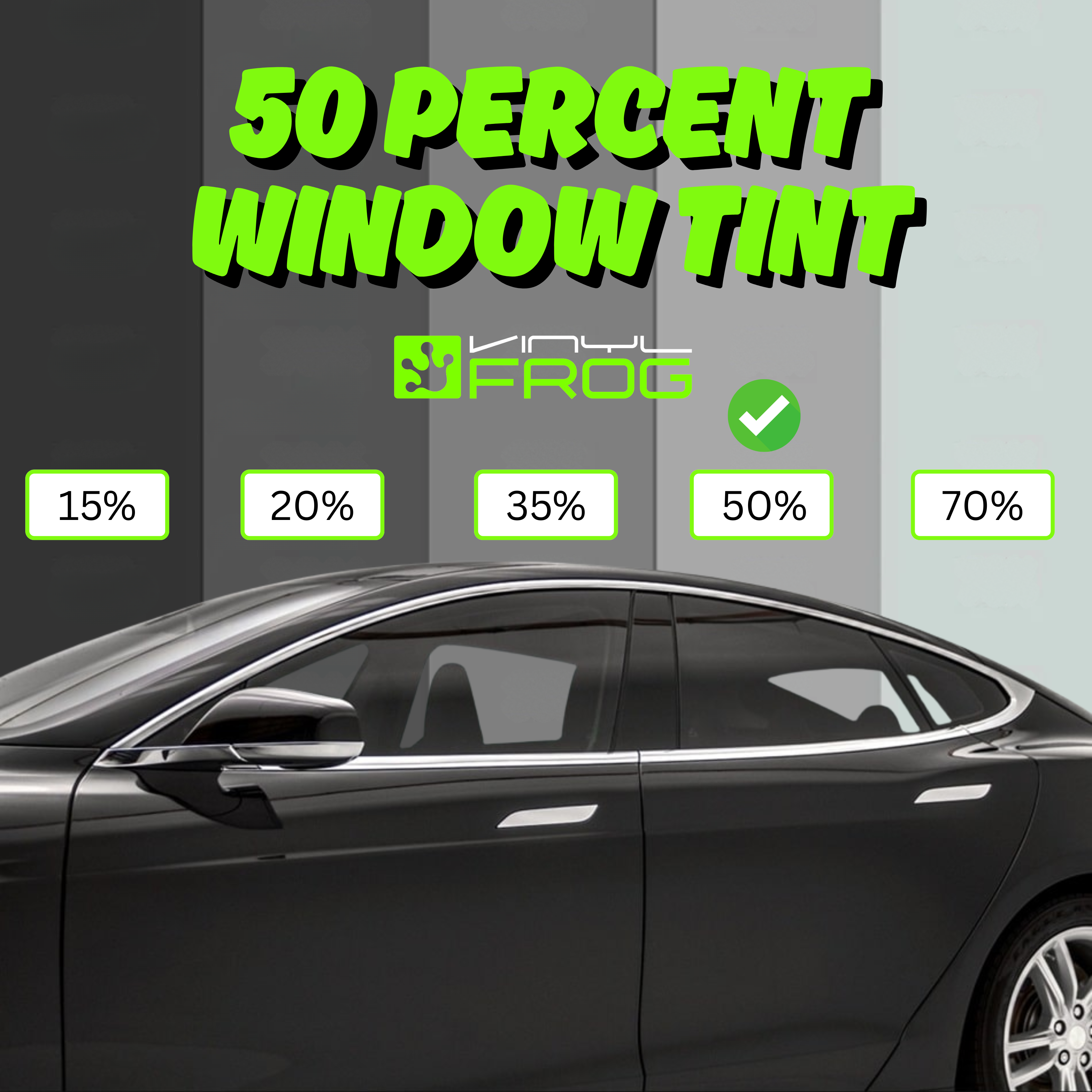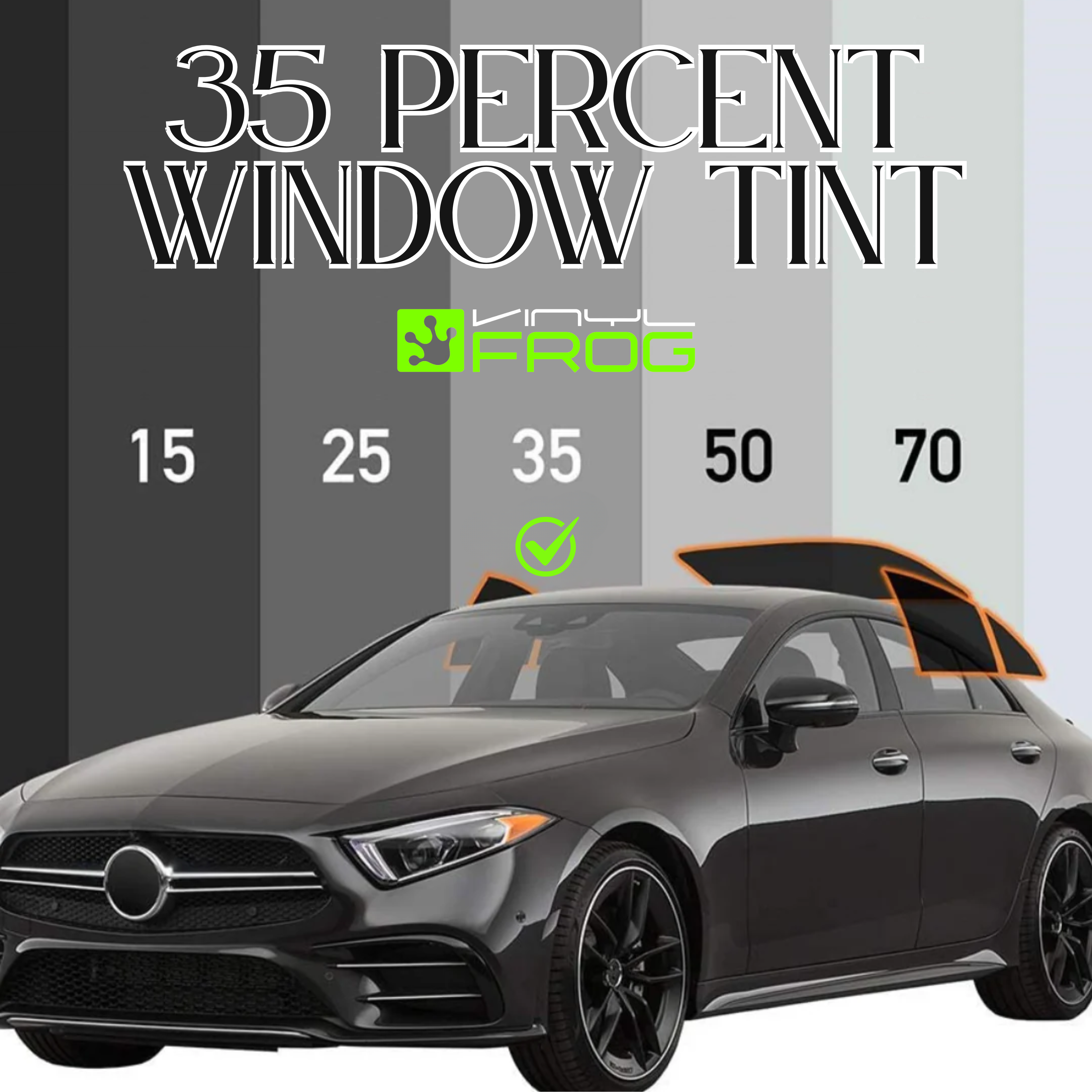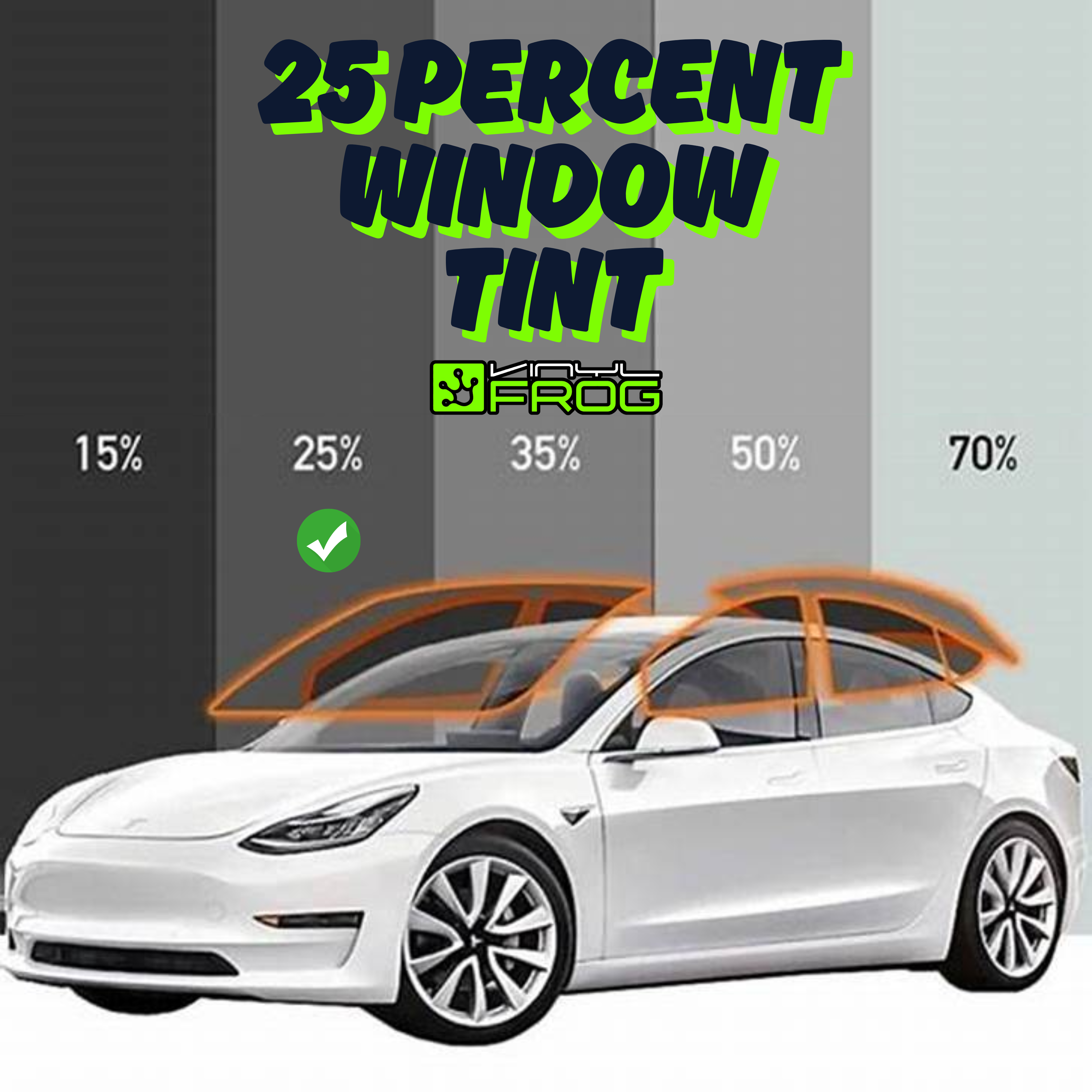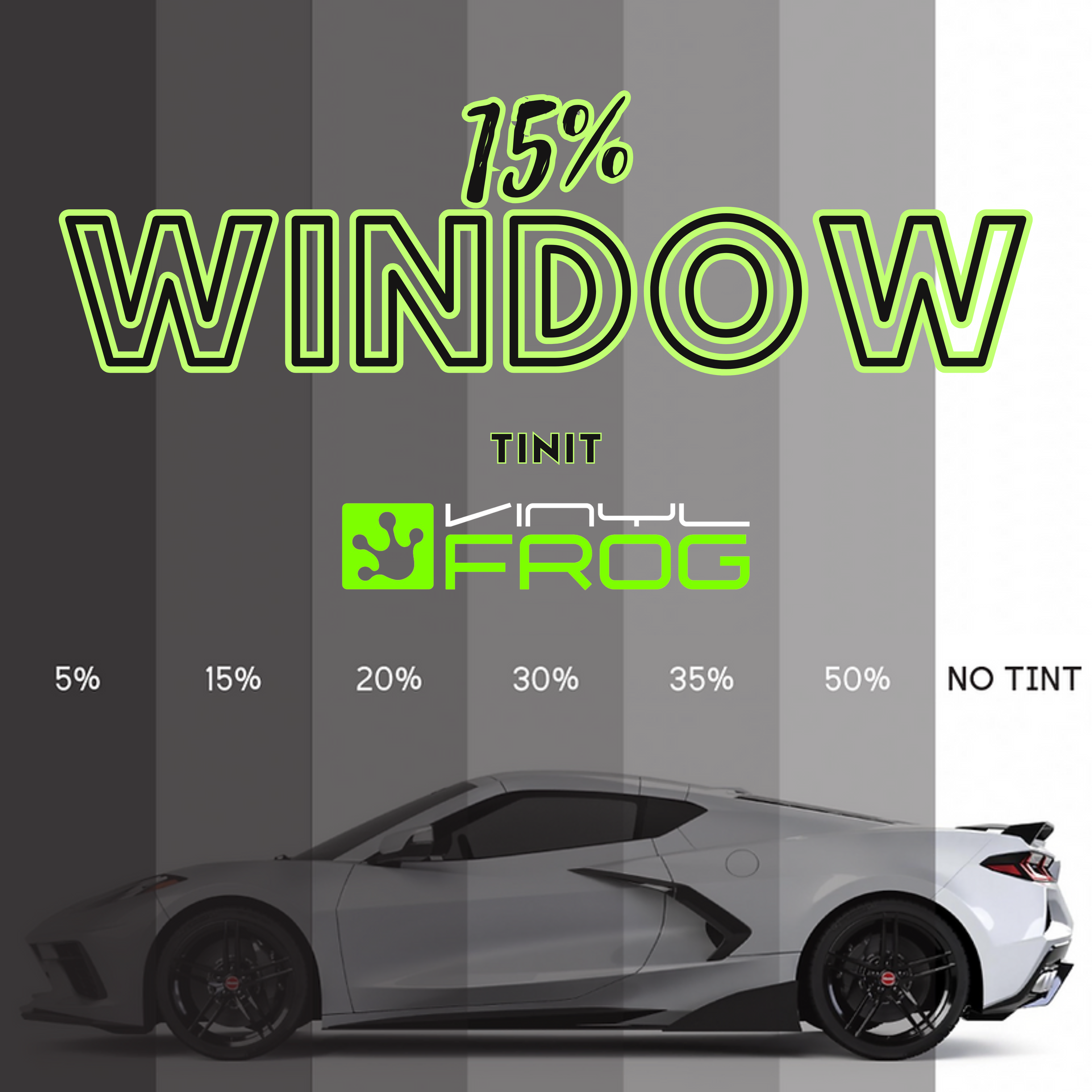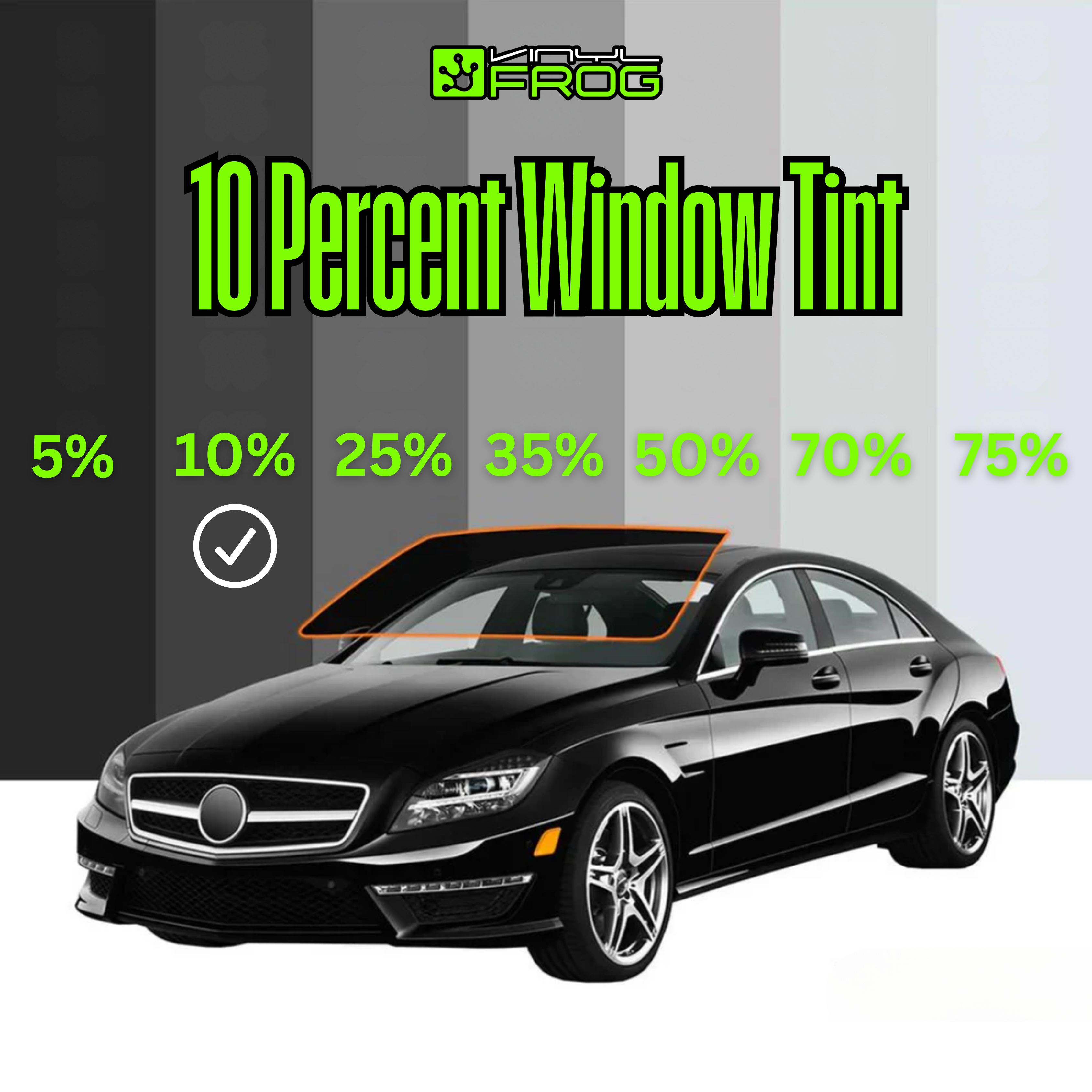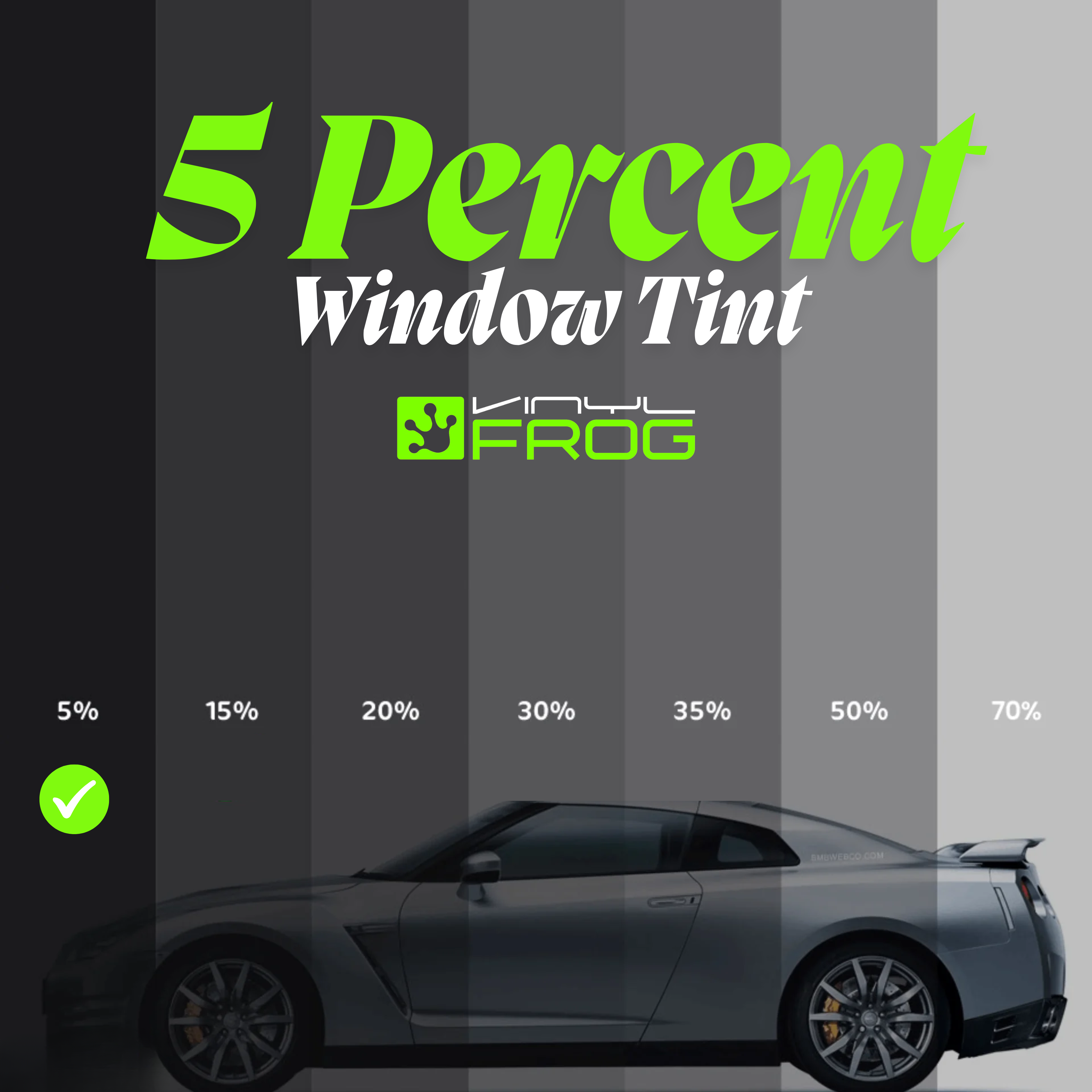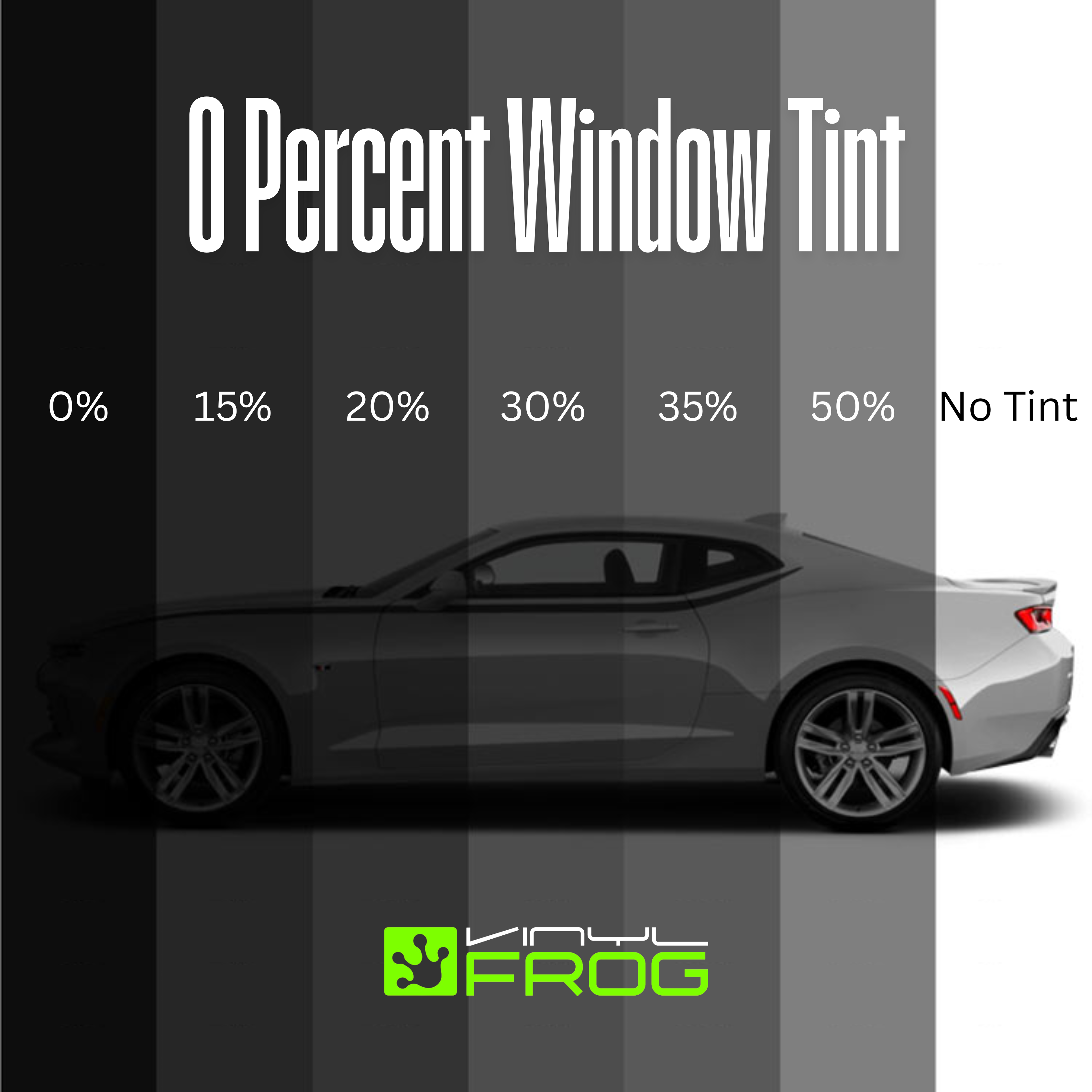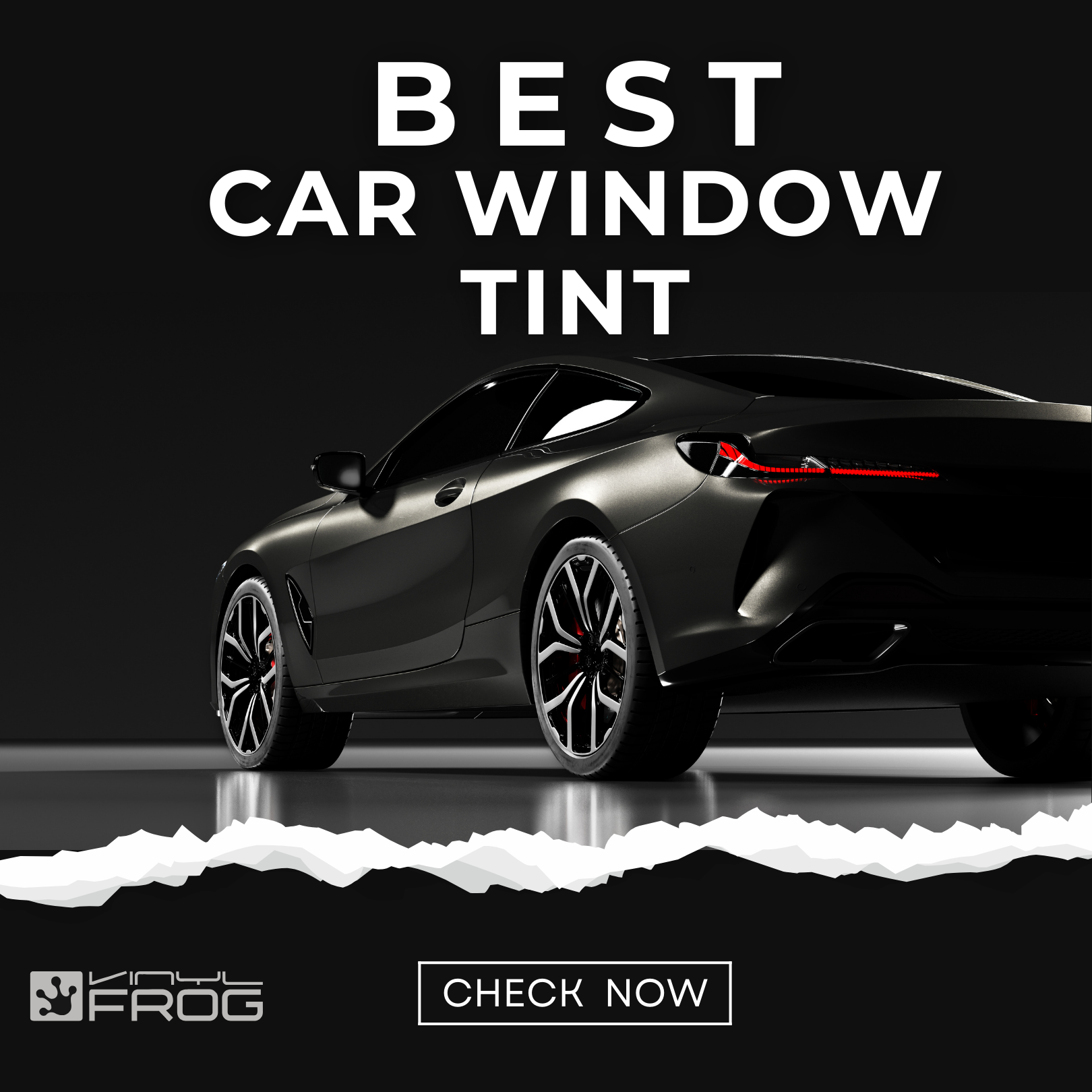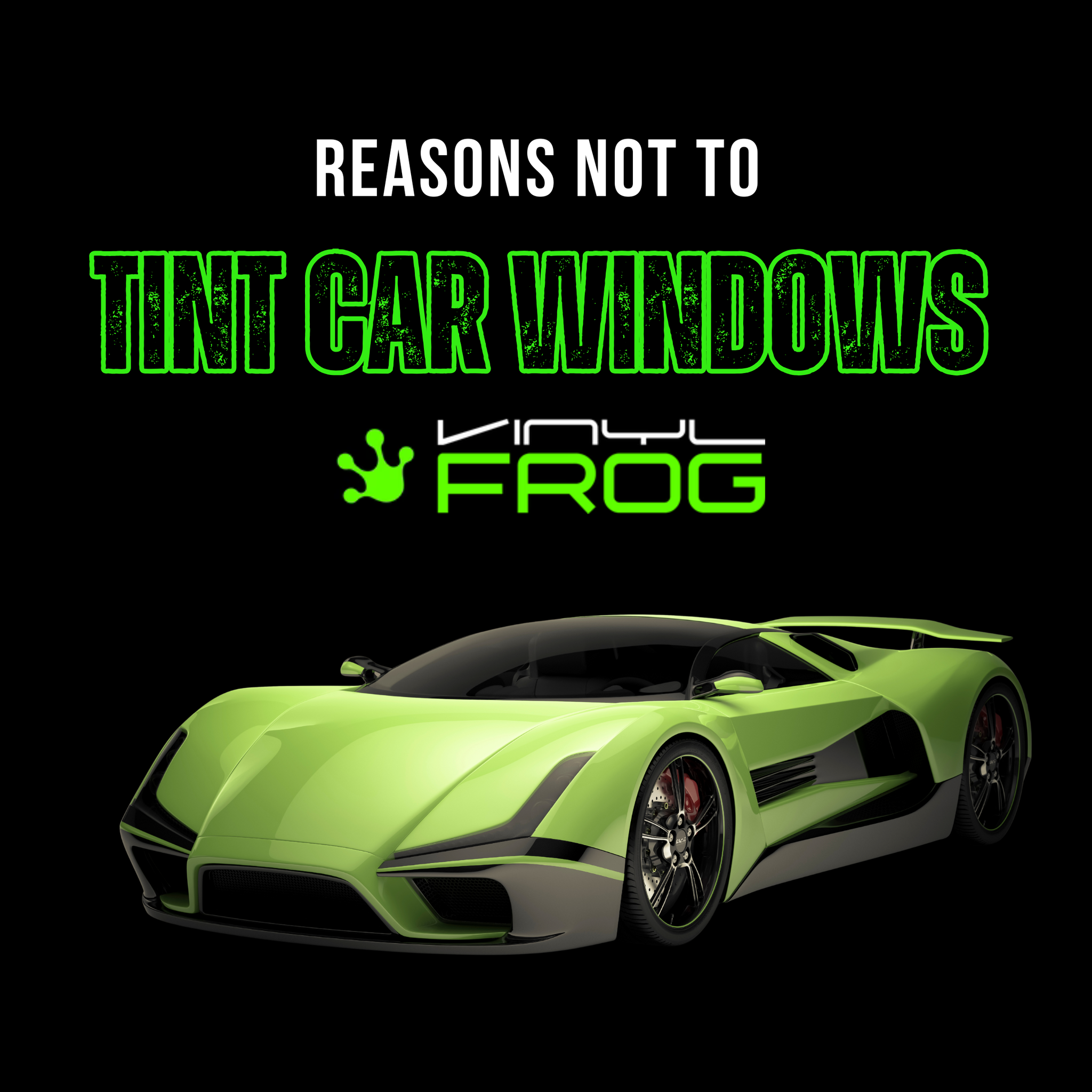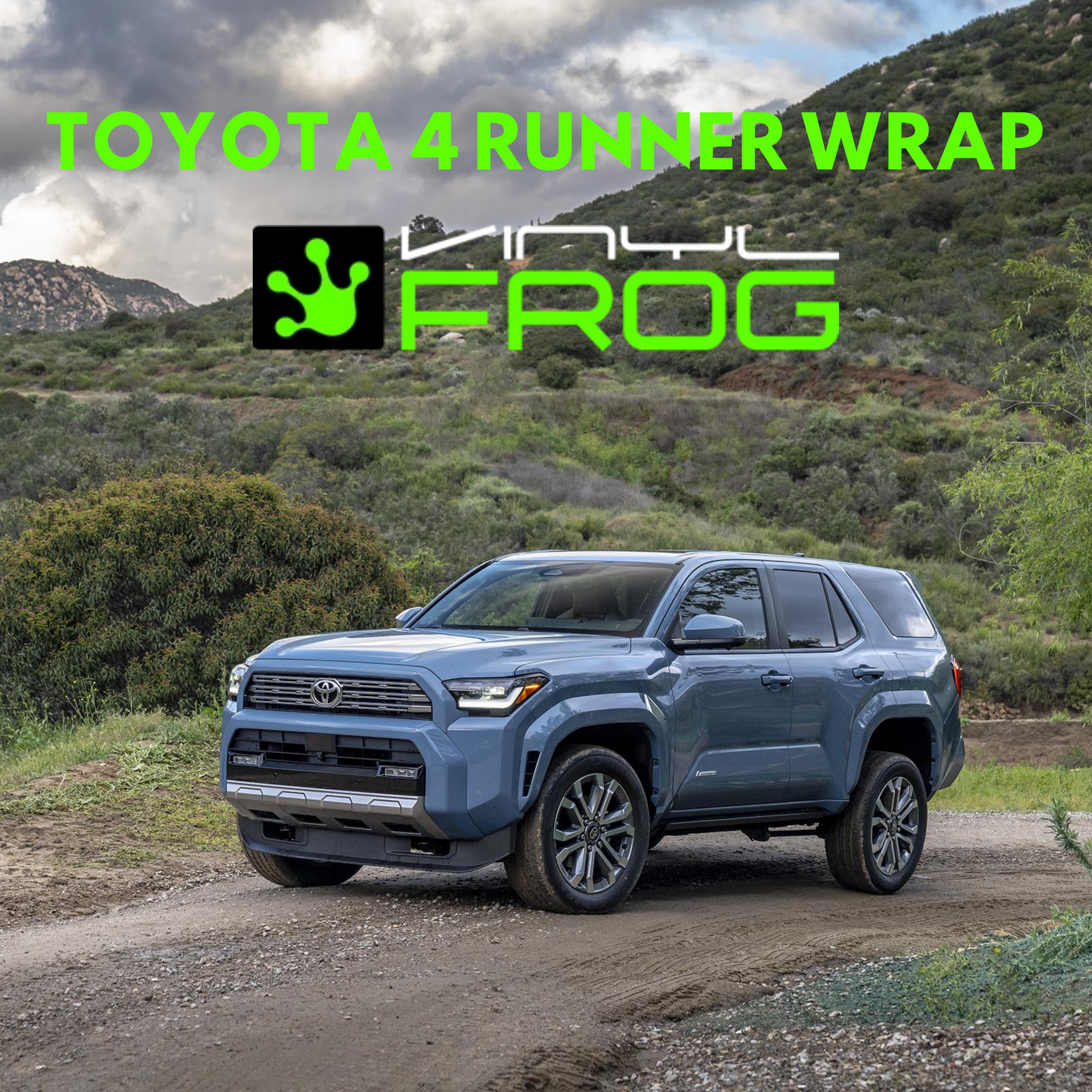Posted By Vinyl Frog On March 3, 2025
Window Tint Percentages
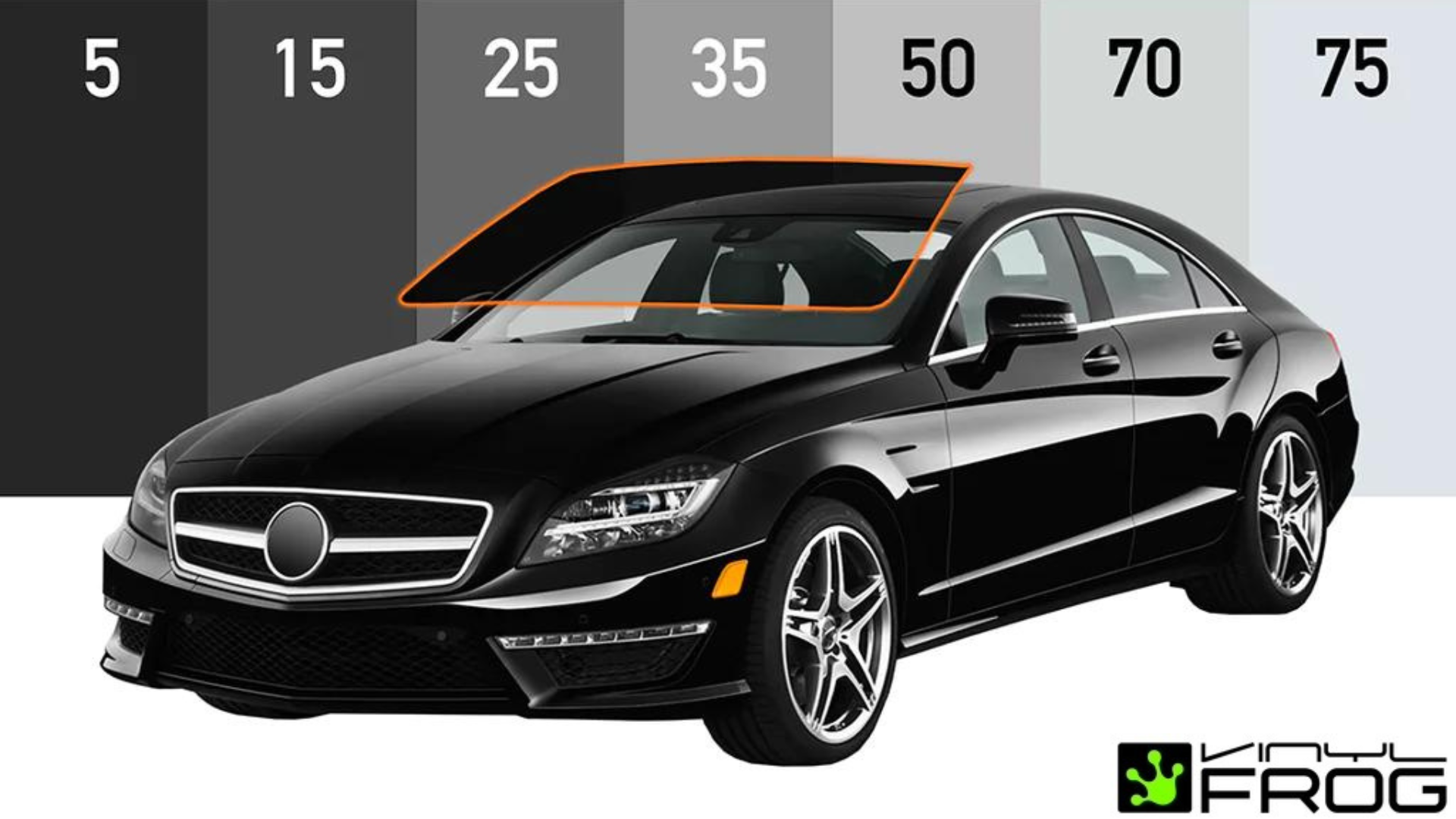
Window tint percentages show how much light passes through your car’s windows the lower the number, the darker the tint. For example, a 20% tint blocks 80% of light, offering more privacy and UV protection, while a 70% tint looks lighter and clearer.
Choosing the right tint percentage matters for visibility, comfort, and legal compliance. Quality films can block up to 99% of UV rays and cut heat by nearly 60%, according to the International Window Film Association.
However, most regions limit front window tints to around 35% VLT for safety reasons.The various percentages of car window tints enable owners to choose the ideal appearance for their vehicles.

Window Tint Percentages are often expressed as a range, such as 5%, 20%, 35%, 50%, and 70%. The lower the percentage, the darker the tint. For example, a window with a tint percentage of 5% is very dark and allows only 5% of visible light to pass through, while a window with a tint percentage of 70% is much lighter and allows 70% of visible light to pass through.
Things You Should Know Before Getting Your Windows Tinted?
- Check Local Laws: Tint limits vary by state or country. Always confirm legal VLT percentages before choosing a film.
- Understand Tint Levels (VLT): The lower the VLT, the darker the tint. A 20–35% range usually offers the best mix of privacy, visibility, and style.
- Choose Quality Film: Ceramic tint delivers the best UV, heat, and glare protection far superior to dyed or metalized films
- Pick a Reputable Installer: Skilled professionals ensure a flawless, bubble-free finish that lasts for years.
- Let It Cure: Avoid rolling windows down or cleaning them for 2–5 days after installation to prevent peeling or damage.
- Know Its Limits: Tint reduces heat and UV rays but doesn’t make windows unbreakable or fully reflective.
- Maintain It Right: Use ammonia-free cleaners and a microfiber cloth to keep clarity and prevent film damage.
- Consider Night Driving: Darker tints (5–10%) reduce night visibility — 20–35% is safer and more balanced.
⚡ Pro Insight: If you want the best results, go with ceramic tint professionally installed at a legal VLT for your area. It gives you the cleanest look, the longest lifespan, and the best heat rejection.
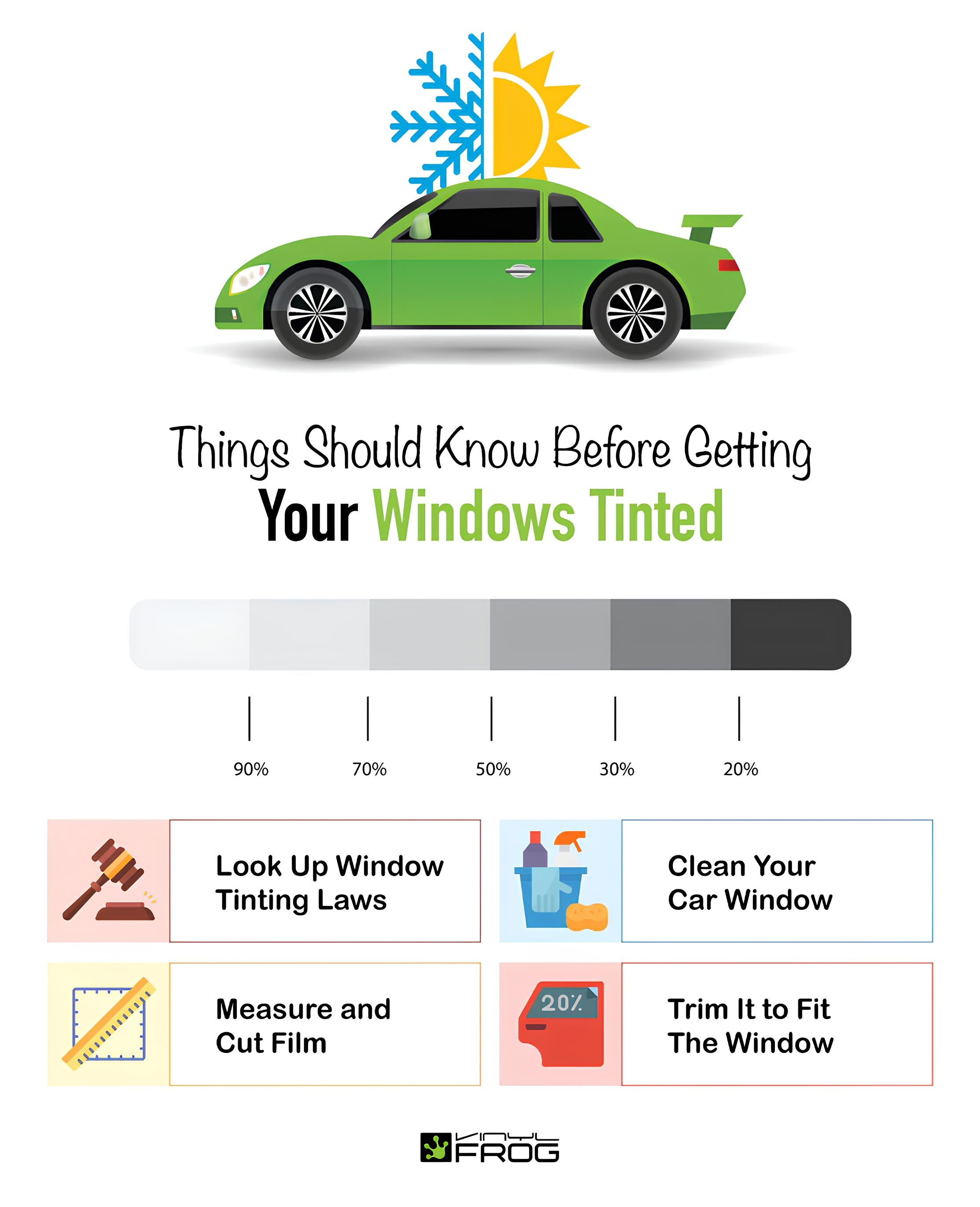
Different Window Tint Percentages
There are different window tint percentages available on the market that refer to their VLT. These affect the glare, visibility, heat and the privacy of the passengers. Let’s have a detailed description of each.
80% Window Tint - Crystal Clear Finish for Maximum Visibility
80% tint keeps your windows looking clear but adds a layer of UV and heat protection. It’s ideal if you want the benefits of tinting without a dark or noticeable shade.
70% Window Tint – Minimal Darkness, Maximum Comfort
70% window tint allows 70% of visible light to pass through, meaning only 30% is blocked when exposed to sunlight or bright lights. It doesn’t darken the interior much but creates a subtle smoked effect. Despite allowing plenty of light.
It effectively protects the interior from UV damage.This tint is opaque enough to block harsh sunlight while maintaining a clear view outside. It preserves privacy, keeps your vehicle cool, and reduces air conditioner load improving overall fuel efficiency.
50% Window Tint – Gentle Tint for a Natural, Balanced View
A 50 percent window tint allows approximately 50% of visible light to pass through the window, while the remaining 50% is blocked. This level of tinting provides moderate light transmission, striking a balance between privacy, glare reduction, and visibility. It offers a noticeable tinted appearance while still allowing a significant amount of light to enter the vehicle.
This tint percentage is considered to be highly effective against UV rays and great for temperature control. It blocks up to half the light, reducing discomfort caused by reflection. It is allowed in most states however, it is recommended to check the local law before applying it.
35% Window Tint – Perfect Mix of Privacy and Visibility
This is also considered to be an ideal tint percentage for the windows of your vehicle. It indicates that 35 percent of visible light can pass through the vehicle's windows, while the remaining 65 percent is blocked. This level of tinting offers a moderate level of darkness, providing increased privacy and glare reduction compared to lighter tints. It still allows a significant amount of light into the vehicle, maintaining good visibility during the day and moderate visibility at night.
A 35% tint does not allow the harsh, hot rays of the sun to penetrate hence the interior stays comparatively cooler leading to fuel efficiency. At night, it is easy to see through this tint. It does not obstruct the view. It is also legal in most states. To be on the safe side, do not forget to check the regulations in your state regarding window tinting.
25% Window Tint – Strong Privacy with a Clean Finish
A 25 percent window tint means that roughly 25% of visible light can pass through the window, while the remaining 75 percent is blocked. This level of tinting provides a noticeably darker appearance and offers increased privacy, glare reduction, and heat rejection compared to lighter tints.
While it still allows some light into the vehicle, visibility may be reduced, especially at night or in low-light conditions.
20% Window Tint – Mix of Privacy and Performance
This is quite a dark window tint percentage. It implies that around 20 percent of visible light is permitted to pass through the window, while approximately 80 percent is blocked. This level of tinting creates a moderately dark appearance, providing increased privacy, glare reduction, and heat rejection compared to lighter tints.
20 percent window tint is not allowed in most states, especially on the front side windows, to the left and right of the driver. It is essential to check the legal requirements and regulations in your jurisdiction to ensure that this tint percentage complies with the permissible limits for your specific windows.
15% Window Tint – Strong Shade and Built for Privacy
This is a very dark tint percentage. It means that approximately 15 percent of visible light is allowed to pass through the window, while approximately 85 percent is blocked. It provides a high level of privacy, making it difficult for people outside the vehicle to see inside. It also effectively reduces glare from sunlight and headlights, which can reduce eye strain.
Before applying this tint percentage, you have to check the laws and regulations in your jurisdiction. Some areas have specific restrictions on how dark the tint can be, especially for certain windows like the front windshield and front side windows. Ensure that a 15 percent tint adheres to the legal requirements.
10% Window Tint – Darkness with High-End Look
10 percentage tint offers quite a high level of darkness. It means approximately 10 percent of visible light can pass through the window, while roughly 90 percent is blocked. It provides a high level of privacy, as it significantly restricts the visibility into the vehicle from the outside. It effectively reduces glare from sunlight and headlights, improving visibility and reducing eye strain. This can be particularly beneficial if you frequently drive in bright or sunny conditions.
A downside is that it can negatively impact visibility, especially in low-light or nighttime situations. Ensure that you are comfortable with the potential decrease in visibility before choosing this tint level. Also verify the laws and regulations in your jurisdiction regarding window tint percentages.
5% Window Tint – Bold Blackout Finish
This is often known as limo tint. It allows only 5% of visible light through the window while blocking 95% of it. It is regarded as the market's most high-tech window tint. The interior of the car is barely visible from the outside. This is frequently used in limos, which is where the name originates.
Limo tint provides the highest level of privacy. Its dark nature effectively reduces glare from sunlight and headlights. It also has excellent heat-rejecting properties, helping to keep the interior of the vehicle cooler and improving overall comfort. It provides strong protection against harmful ultraviolet (UV) rays as well.
This 5 percentage tint has a sleek and stylish appearance that enhances the overall look of the vehicle, making it more sophisticated and luxurious. It's important to note that several state laws forbid manufacturers and even drivers from selling and installing such window tints.
0% Window Tint – Absolute Darkness, Zero Visibility
0 percent tint means complete blackout. Light is not able to pass through this tint percentage. This tint blocks 100 percent of visible light. No one can look inside the vehicle. It provides significant heat and UV protection and helps keep the interior cooler during hot summer days.
It blocks harmful UV rays, which can cause damage to your skin and interior surfaces. It also effectively reduces glare from the sun and other bright sources, improving comfort while driving. Despite all these advantages, this is not an ideal tint to install on your vehicle’s windows.
It considerably reduces the visibility of the driver and impairs the ability to see the road and potential hazards. 0 percent tint might not be allowed in many states hence it's crucial to adhere to local tinting regulations and consider tint options that strike a balance between privacy and visibility.
Identifying The Ideal Window Tint Percentage For Your Vehicle
When it comes to ideal window tint percentage, the finest is the one that doesn't obstruct your vision while still offering sufficient UV protection. The majority of states permit up to 50% VLT for the front windows of the driver and passenger. The most typical limit is 35% Percent VLT for the back window, side windows, and rear passenger windows. This is the most commonly used percentage. It strikes the ideal balance between visibility, privacy, and protection. Depending on the specified window tint regulations of the state where you live, you can even go darker.

Calculating The Percentage Of Tint
It is simple to select the appropriate tint if the windows of your car don't have any tint at all. You will need to choose carefully if your windows already have a tint.
You multiply the factory tint percentage by that of the film to get the outcome. For instance, if you add a 50% film to a window that is already 60% tinted from the manufacturer, you must multiply the two figures together to determine the outcome. For instance, 60% x 50% = 30% tint. Visit a professional if you don't know what percentage of tint your windows currently have. They will evaluate how dark your windows are and assist you in selecting the appropriate tint to achieve your goals.
Different Colors Of Window Tints
Window tints are available in different shades so you can choose the one you like most. These include black, blue, bronze, charcoal, gold and gray. The most popular and commonly chosen color is black as it is the most effective against UV rays and gives the passenger complete privacy. Blue tint also provides extra protection against the harmful rays of the sun. Those who want their vehicle to stunningly stand out go for the gold tint. Gray and charcoal add a classic touch.
Having said that, while opting for a tint color make sure that it is allowed in your state. Check the local laws and if you frequently resort to interstate travel by road, make sure that the tint shade is accepted in the visited state as well before taking any decision.
Important Terms For Window Tinting
- Visible light transmission (VLT) % displays tint darkness.
- A shade band is a rectangular piece of window tint film that extends downward from the top of the windshield.
- The windshield has a marking around the higher corners left by the glass maker called the AS1 line.
- Tint reflection describes the metallic or reflecting quality of the window tint.
Frequently Asked Questions
Final Words
After reading a thorough explanation of the various window tint percentages, you should check your state's rules regarding window tinting before adding tint to your windows. Think about how having darker tinting will enhance the heat, visibility, and appearance of your car.
If you have reached the final decision, go for a high quality tint. Settling for less will only mar the look of your vehicle and will not be beneficial in the long run. When in doubt, leave the calculations to the experts and let them discover the window tint you desire for your car. For excellent window tints, both in durability and performance, visit the Vinyl Frog website!










